3 Unforgettable Wine-Centric Days in Bordeaux, France
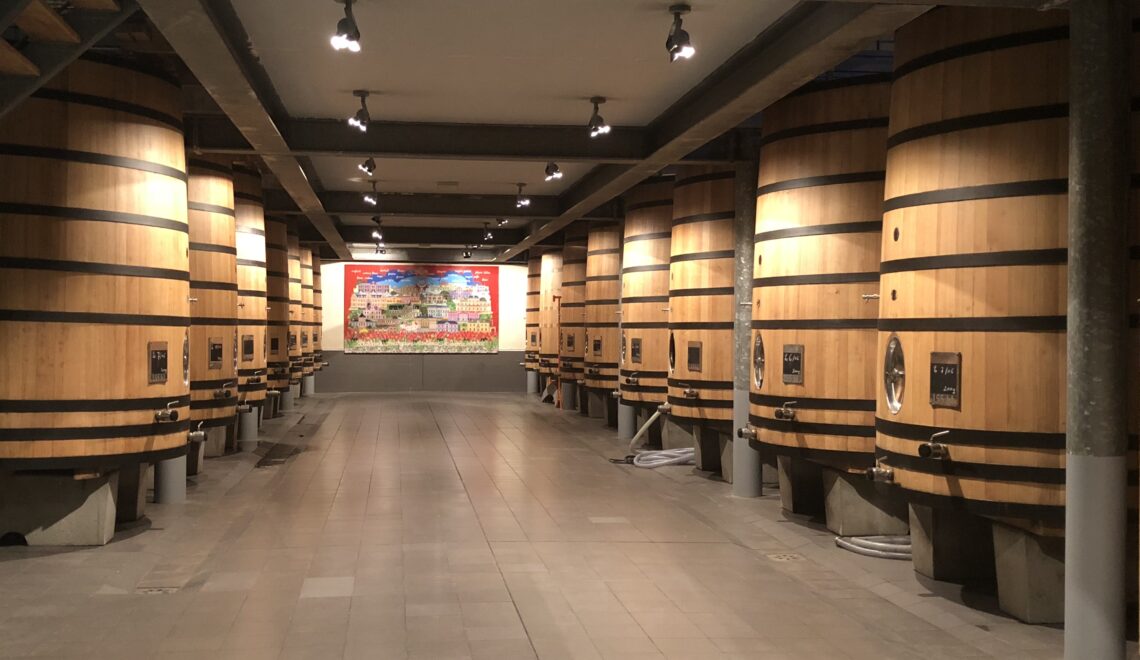
The Bordeaux wine-producing area, located in the Nouvelle-Aquitaine region of France, is said by many to be the wine capital of the world. Surely some might object to that, but it is indisputably near the top. Its most produced and most famous wines are dry reds such as Cabernet Sauvignon, Merlot, and Cabernet Franc. Sauvignon Blanc, a dry white wine, is also produced in some areas.
Bordeaux embraces its rich history, its centuries-old vineyards with grand chateâux, its 80+ miles of leisurely Atlantic coastline, and its vibrant, high-tech, yet still deeply traditional capital city.
The region is divided in half by the Gironde estuary. On the right bank, beautiful vineyards grow on rolling hills, surrounding the medieval village of Saint-Émilion. The area has hundreds of small, family-owned chateâux, going back generations. The small area of Pomerol, where Bordeaux’s most expensive wines are produced, is also located on the right bank.
The Médoc vineyards are on the left bank, planted on flat lands running along a peninsula stretching to the Atlantic Ocean. It is home to enormous, impressive chateâux, and the renowned villages of Margaux, St Julien, Pauillac, and St Esteèphe.
Between the two extraordinary wine-growing areas is the wonderful city of Bordeaux, the best place to base your trip to the region.
** Please note that this post contains affiliate links, meaning we may earn a very small commission if you book/apply through them (at no extra cost to you).
Table of Contents
Day 1 – Explore The City of Bordeaux
With more than a million residents, metropolitan Bordeaux is the 6th largest city in France. As recently as 30 years ago, Bordeaux was a dirty, undesirable port city, full of vacant warehouses, parking lots, and dilapidated buildings. In 1995 Alain Juppé was elected mayor and had a vision for the city. He led the charge to clean up the city, restore the abundant historic sites, develop the riverfront area and create a promenade, and install a sleek tram system to reduce reliance on cars and create pedestrian-only areas. Since then, Bordeaux has been spectacularly transformed, earning it the nickname “Sleeping Beauty”.
In 2007 the city center was declared a UNESCO World Heritage City. Today it is one of the most desirable places to live in France, and one of Europe’s top tourist destinations.
The most photographed site in Bordeaux is the stunning Miroir d’Eau (Water Mirror), spanning a remarkable 37,000 square feet. Honestly, it’s rather difficult to describe. It is a fountain of sorts, also a reflecting pool, also a shallow children’s play area, also a huge granite slab, and also a work of mesmerizing art.
It sits in front of the Place de la Bourse, a series of 18th-century buildings that form a royal square along the Garonne River. The buildings are reflected in the Miroir d’Eau, constantly changing with the position of the sun. Fountains of dense mist rise every 15 minutes to the delight of onlookers (particularly in hot weather!). We dare you to not become obsessed with trying to photograph it – morning, noon, and night.
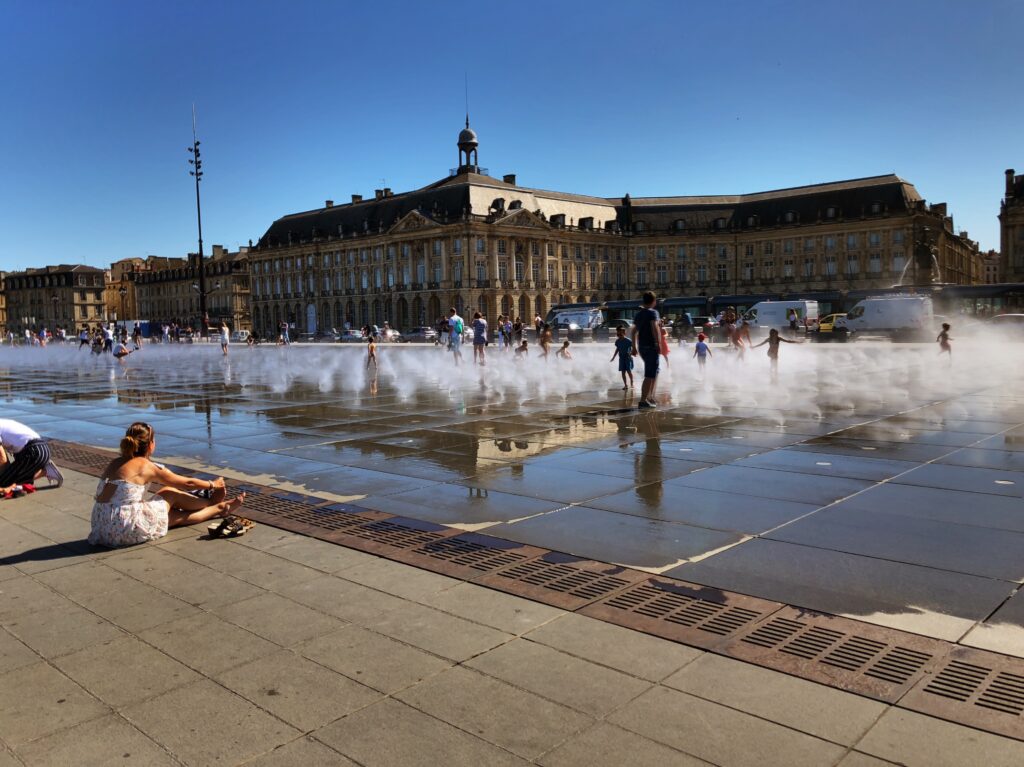
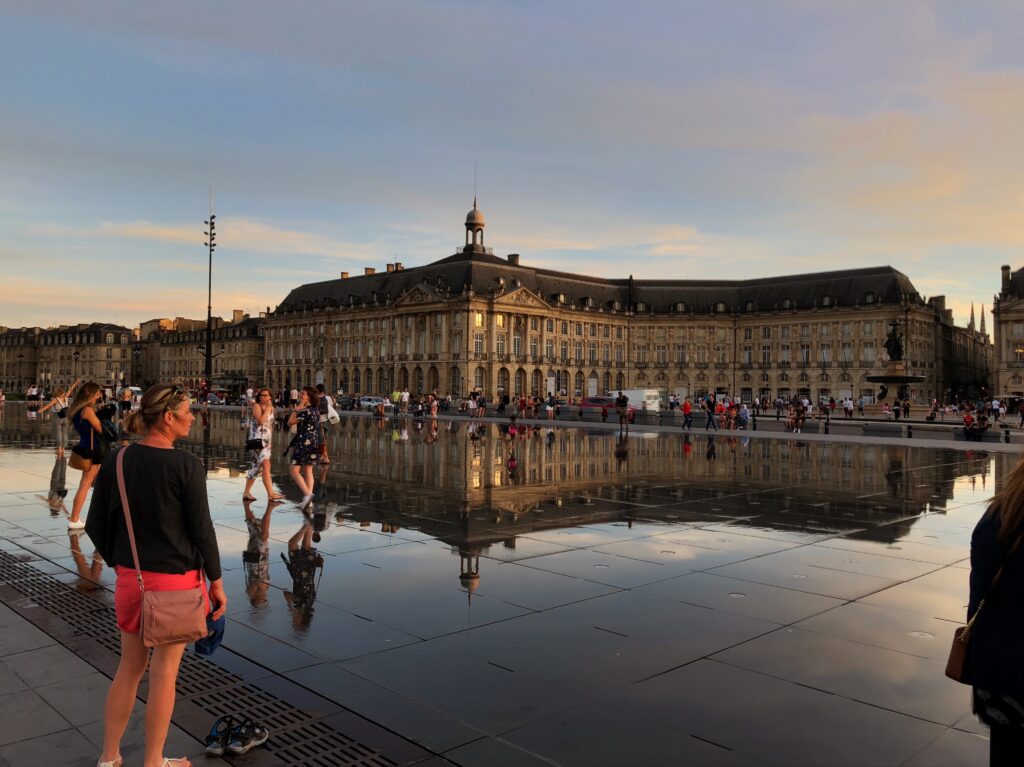
In addition to repeatedly popping by the Miroir d’Eau, here are our suggestions as to how to spend a great day in Bordeaux:
Morning:
Take a quick 10-minute tram ride (just €2) to Bordeaux’s Cité du Vin (City of Wine). The museum, completed in 2016, is an ultra-modern, high-tech, interactive smorgasbord of information for wine lovers, and the wine-curious.
The swirling, reflective building invokes the feeling of perpetual motion. The feeling continues upon entering. Inside, it is intended that visitors feel like they are going through the building as if they’re on a river flowing around the central staircase.
“This building does not resemble any recognisable shape because it is an evocation of the soul of wine between the river and the city.” – Architects Anouk Legendre and Nicolas Desmazières
The 18 permanent exhibits cover wine history, past and current winemaking, environmental factors, global wine regions, wine aromas, and a very fun room exploring wine and food pairing techniques. Of course, there is a section specifically covering Bordeaux wines. It took us about 2 hours to tour the museum, participating in most, but not all, of the interactive attractions.
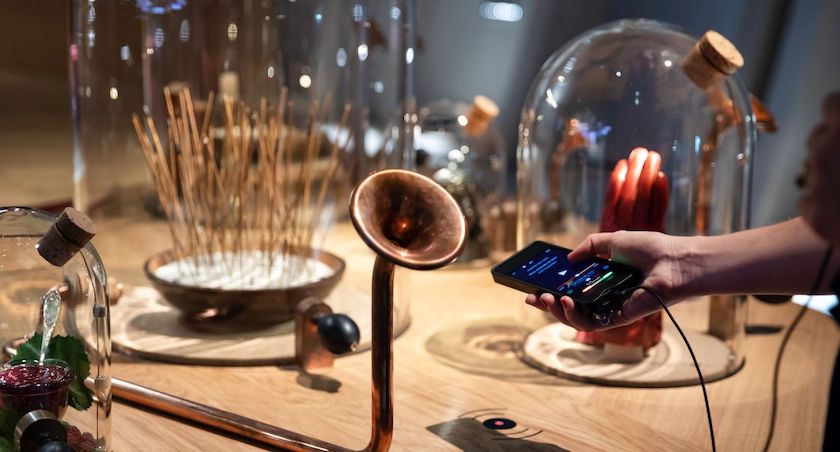
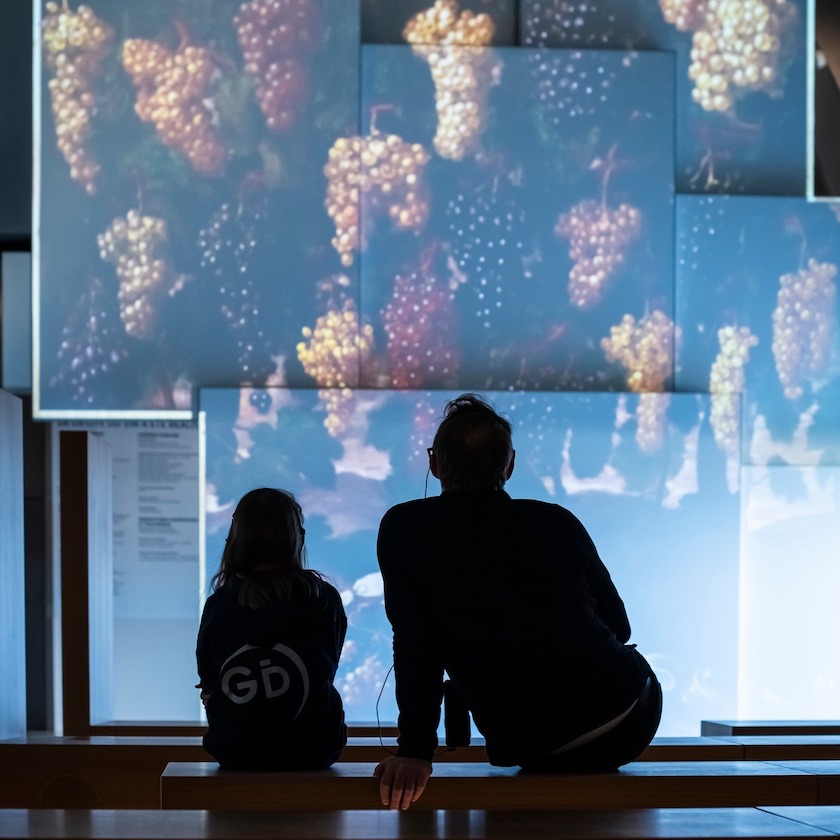
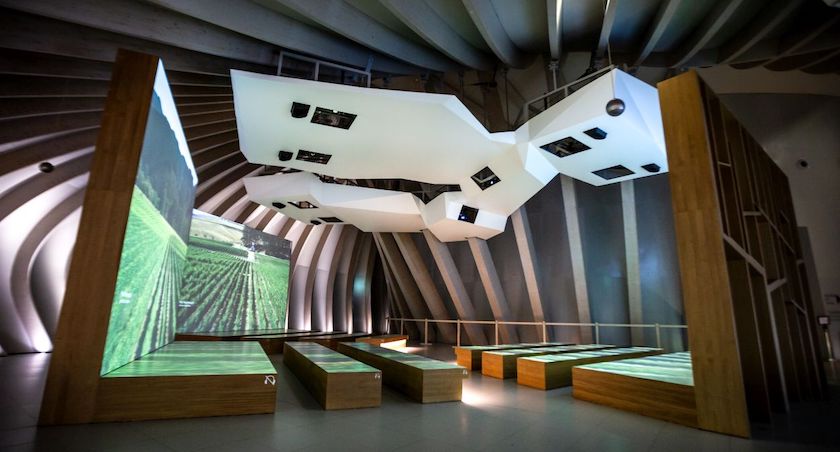
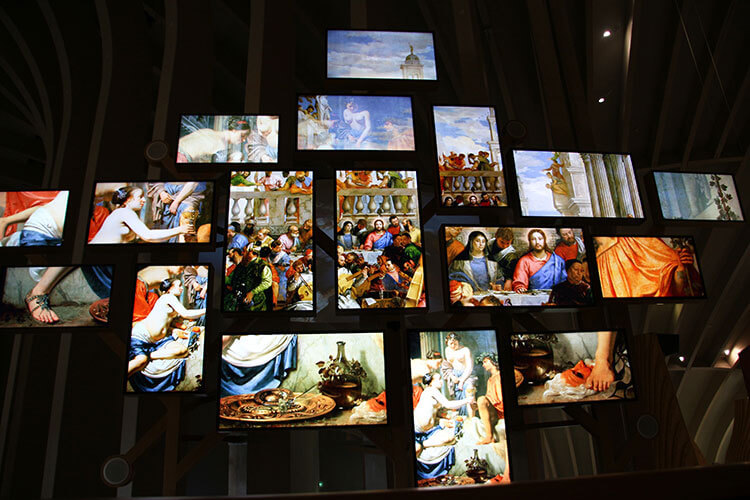
After you’ve finished in the museum, your ticket gives you access to an elevator to the 8th (top) floor, with gorgeous 360-degree views over Bordeaux, the Garonne River, and the surrounding areas. Your ticket also gets you a glass of wine from the tasting bar located on the same floor.
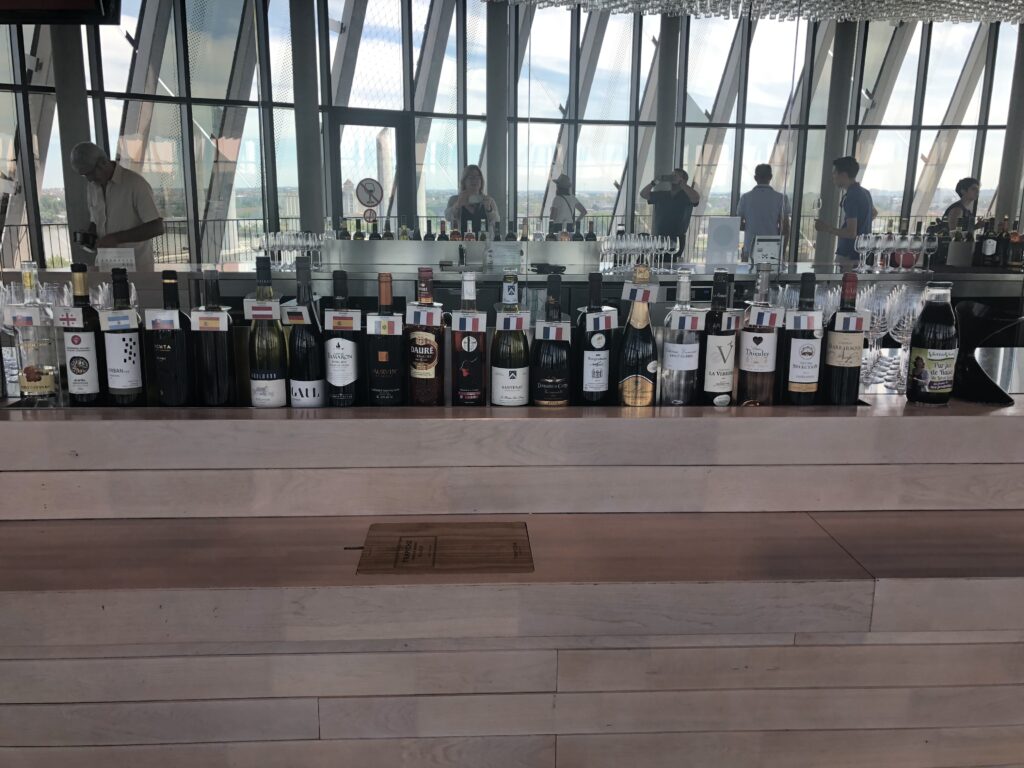
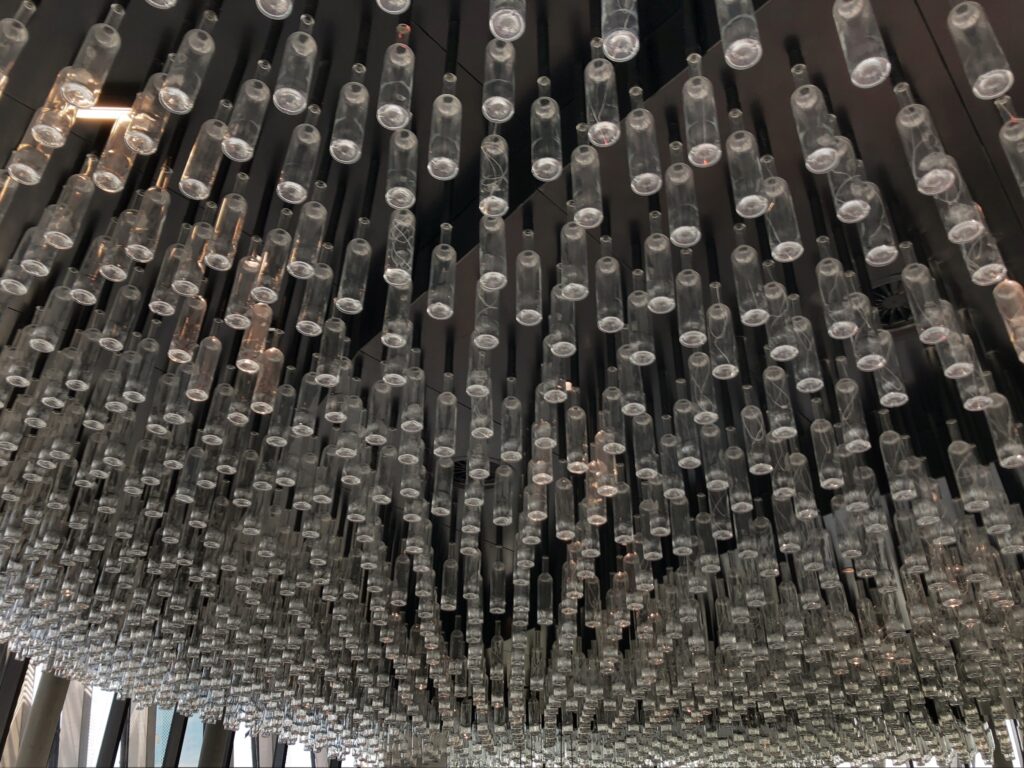
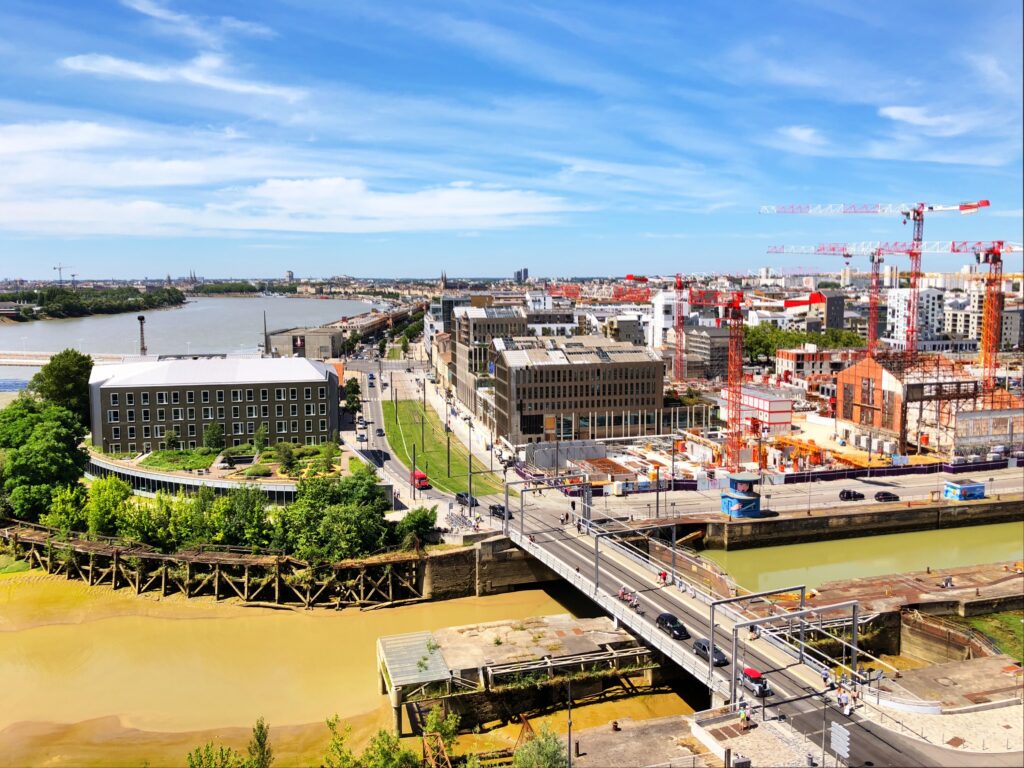
One floor below is Restaurant Le 7, offering equally panoramic views, and serving lunch and dinner, as well as drinks and snacks in between meal times.
In the cellar level of the building, Latitude 20 offers the opportunity to purchase bottles of wine from more than 70 countries, with the assistance of sommeliers.
Lunch:
Just across the street from the museum is the glorious Les Halles Bacalan. We stumbled upon the large, indoor market by happy accident. It is filled with butchers, oyster sellers, cheesemongers, bakeries, wine merchants, and anything else you can think of. Many of the stands have places to sit and enjoy a meal or snack.
We ended up “pulling up a stool” to a little counter (seating maybe 10 people) offering charcuterie platters. The four staff members were incredibly friendly and funny. A few minutes after we sat down they brought us this ridiculously fabulous platter of meat. Oh, and peppers. So… meat and vegetables, right? It was absolutely delicious.
Afternoon / Evening
You have a choice of transportation back to the center of Bordeaux. Tram or feet! It is about 2.5 miles, but it is an entertaining walk filled with great street art. Most of the walk is along the river, lined with cute shops and cafes for a good part of the way. Of course, the tram is much faster.
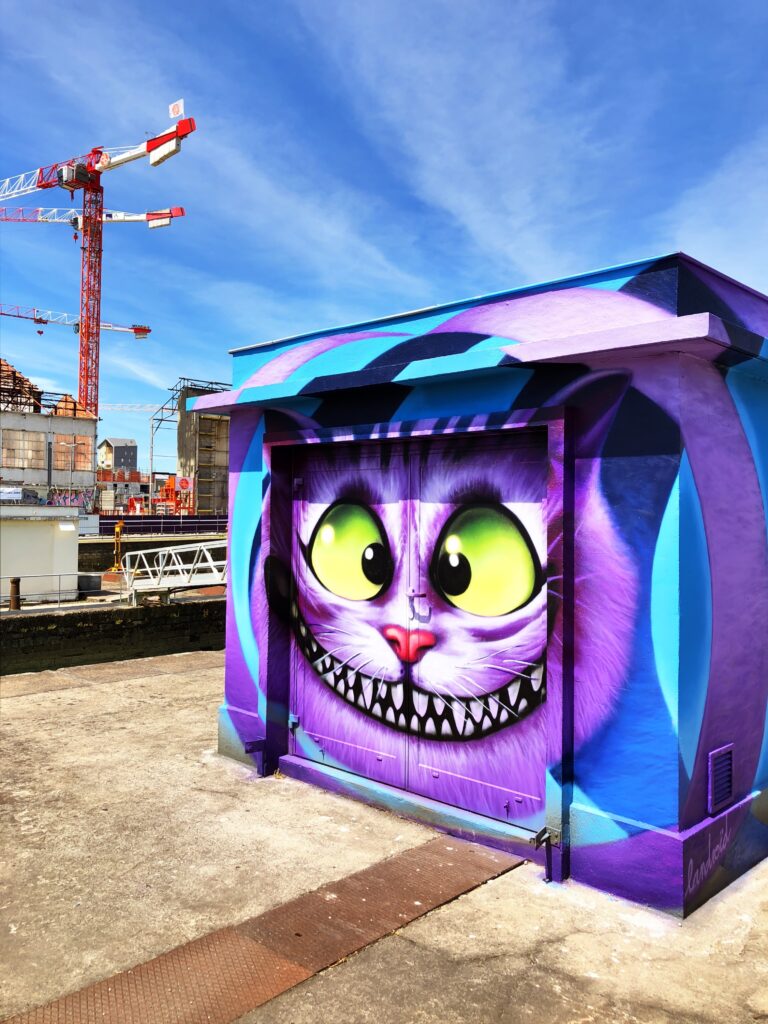
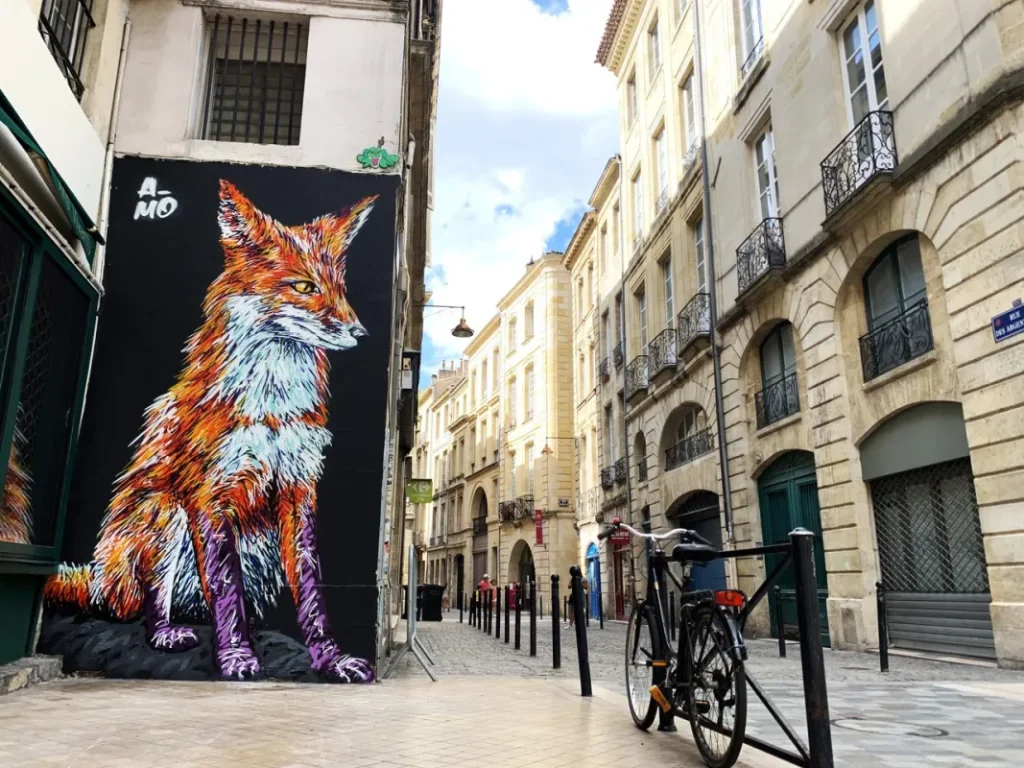
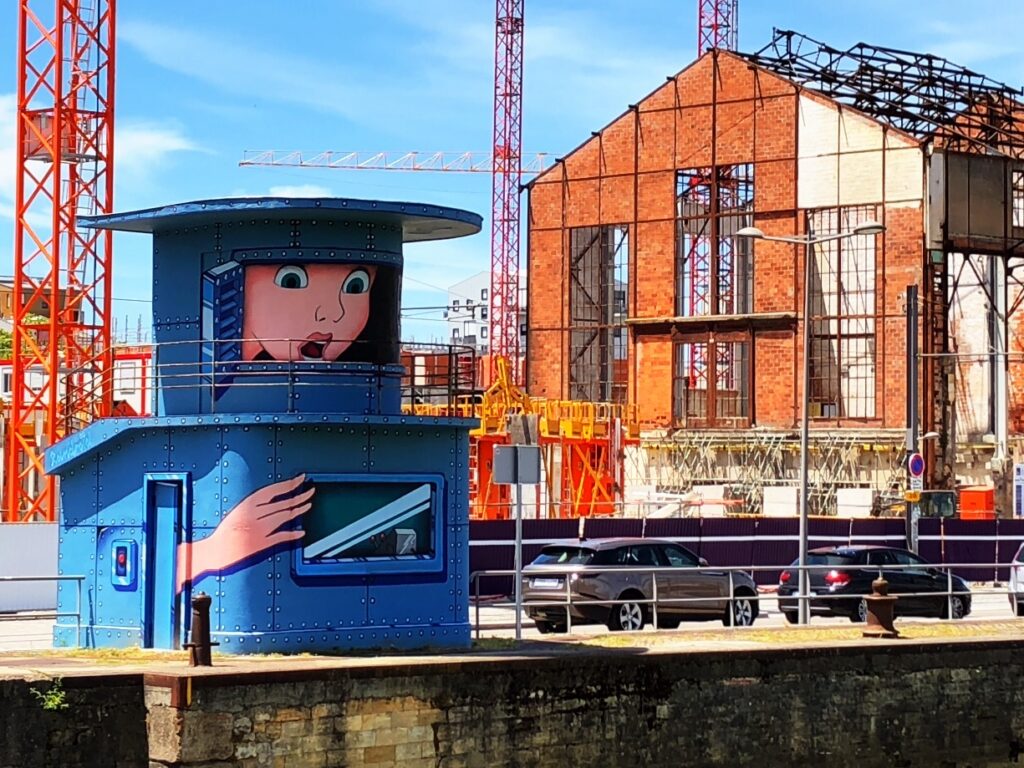
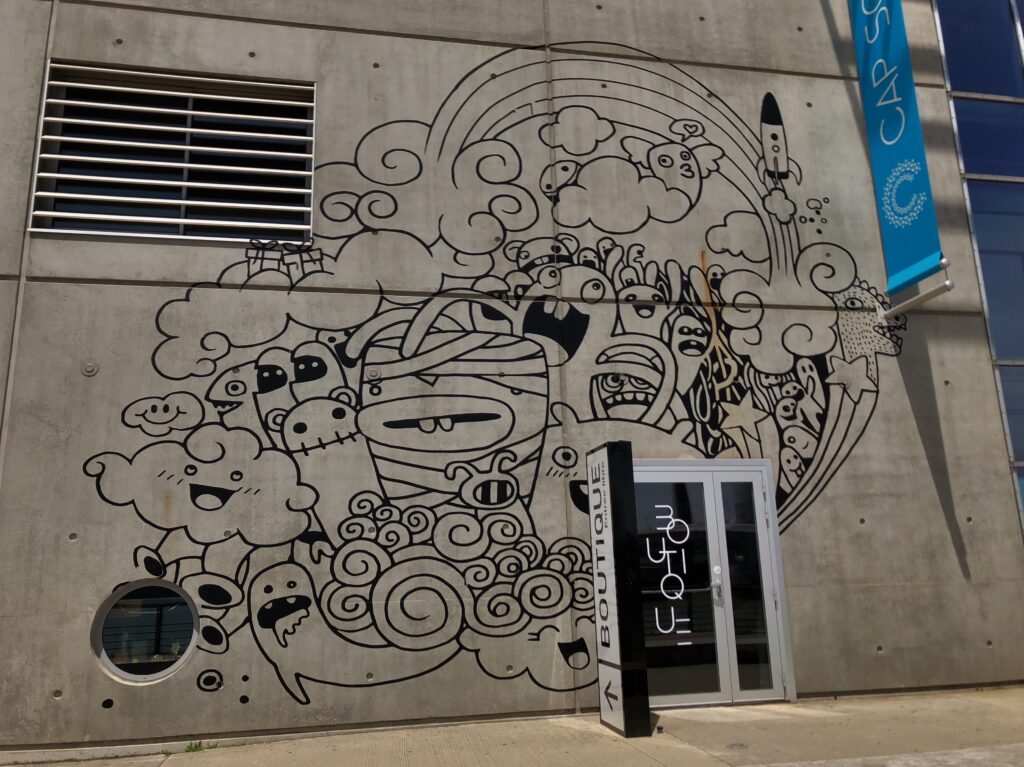
Back in central Bordeaux, there are many sites within walking distance from which to choose.
Musée d’Aquitaine covers the history of Bordeaux, and of Aquitaine, the region of France in which it sits. The museum displays well over a million artifacts dating from pre-historic times up to the 20th century. It is a blissfully uncrowded place, and we often found ourselves alone in entire rooms. Rotating special exhibits are featured covering everything from ancient Egypt to Jack London. It is an inexpensive and well-done museum.
Port de la Lune (Port of the Moon) is the oldest and most beautiful district in Bordeaux. The entire area was awarded UNESCO World Heritage status in 2007, at that time the largest area to receive such status in the world. It has the most protected buildings of any city in France, other than Paris.
The Miroir d’Eau (see above) is located in the Port de la Lune. From there, is an easy stroll to view a host of incredible sites with highlights including the Gothic Cathédrale Saint-André, (also known as the Bordeaux Cathedral, and seat of the Archbishop of Bordeaux), the Musée des Beaux-Arts, St Michael’s Basilica, the Fountain of Three Graces, and the spellbinding Monument aux Girondins.
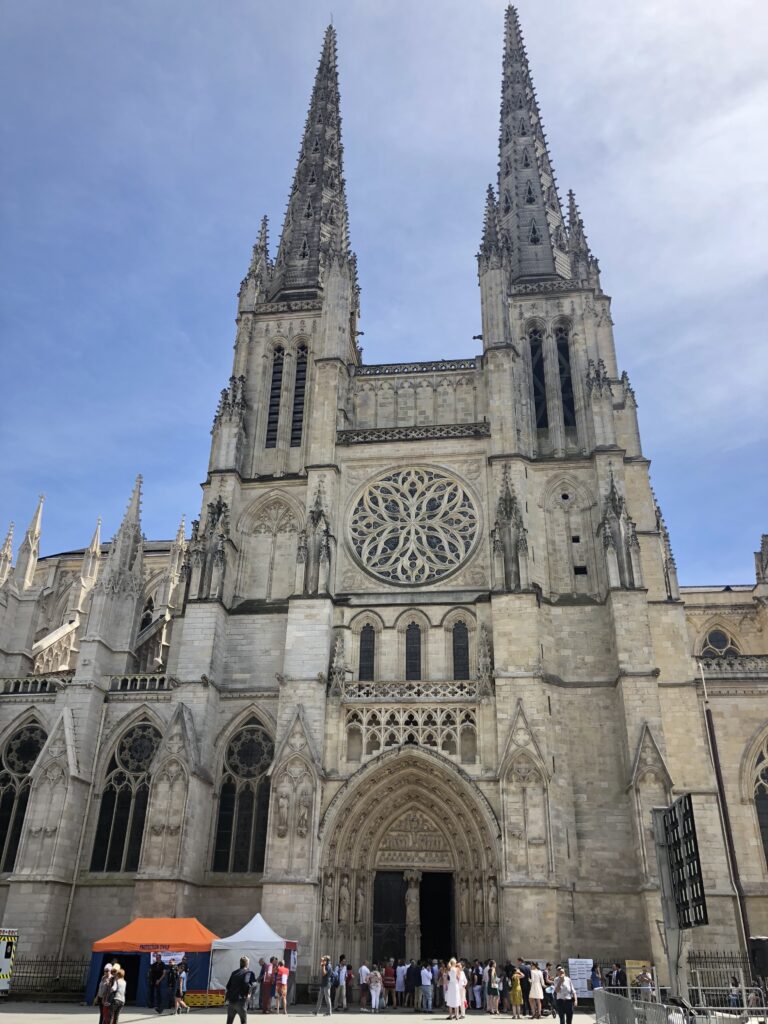
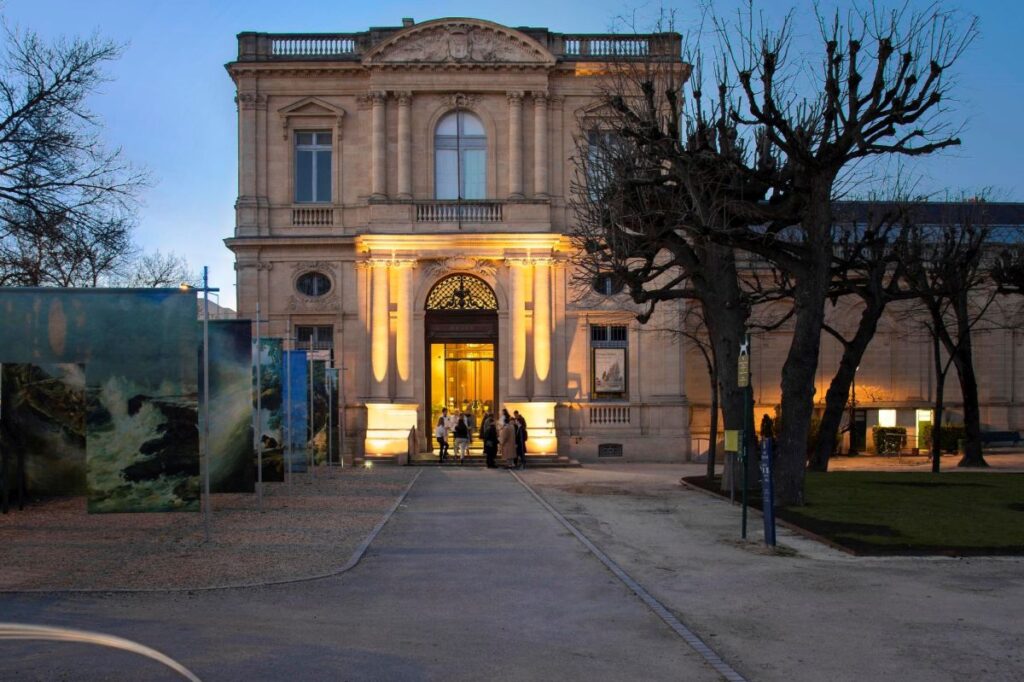
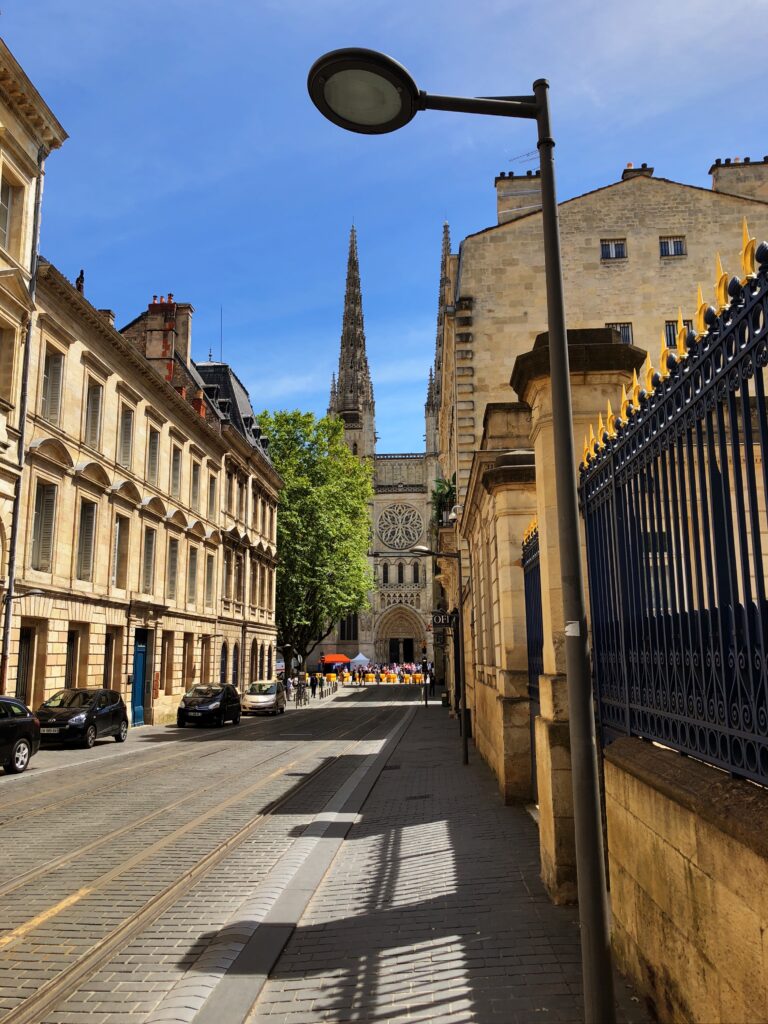
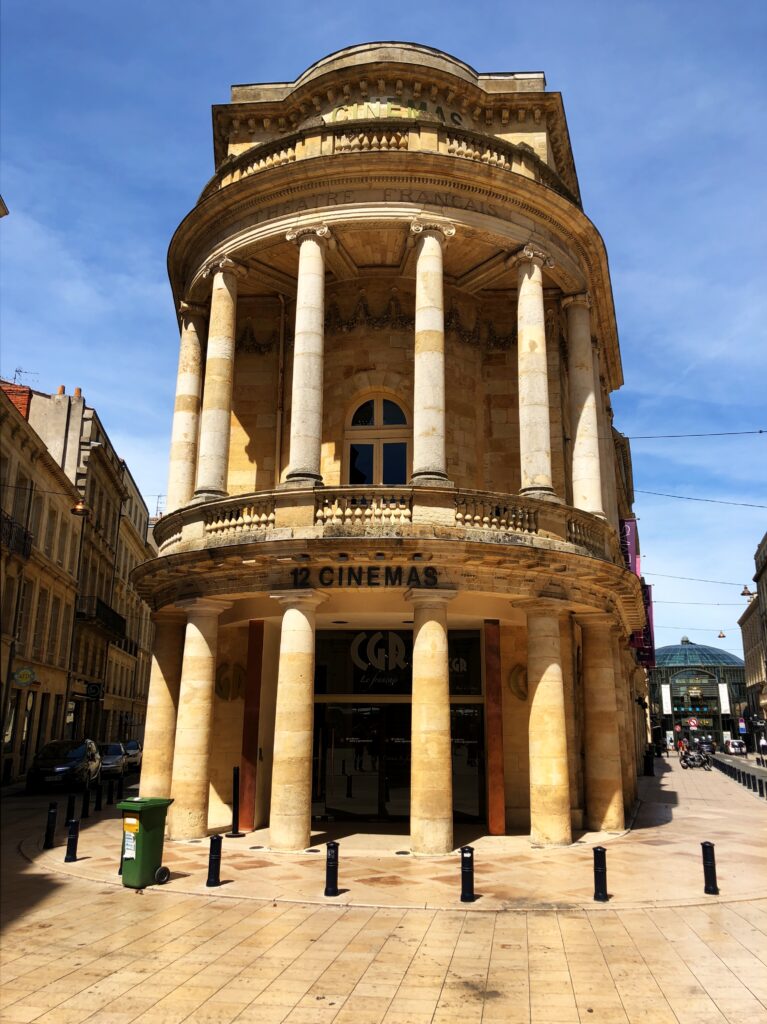
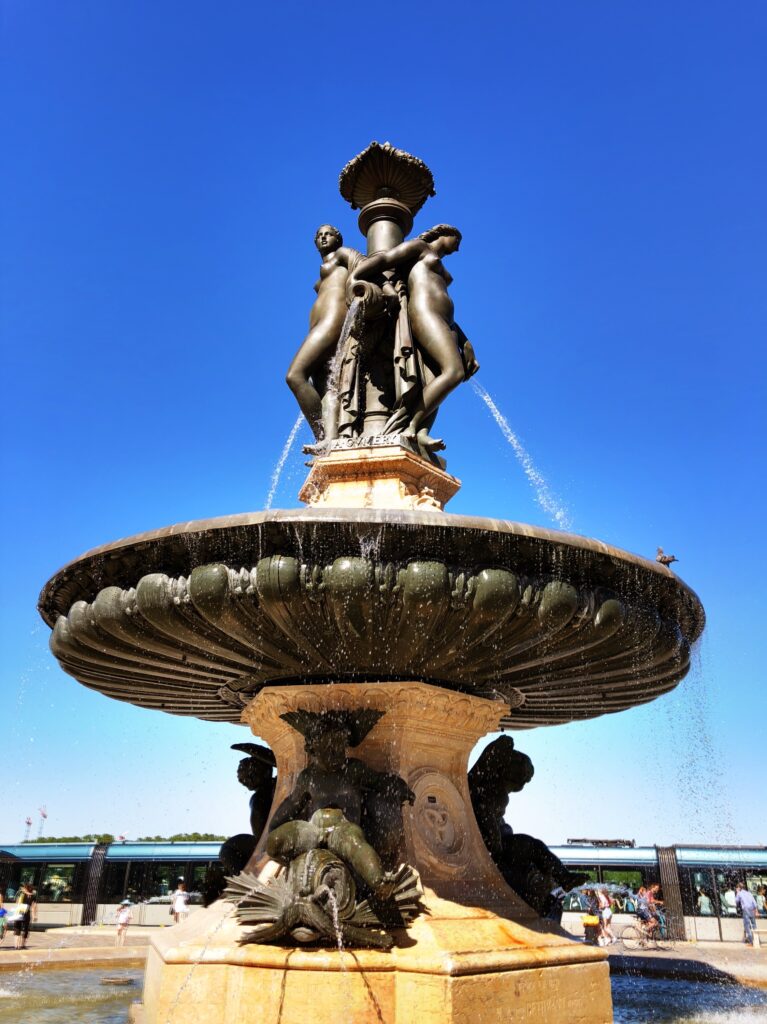
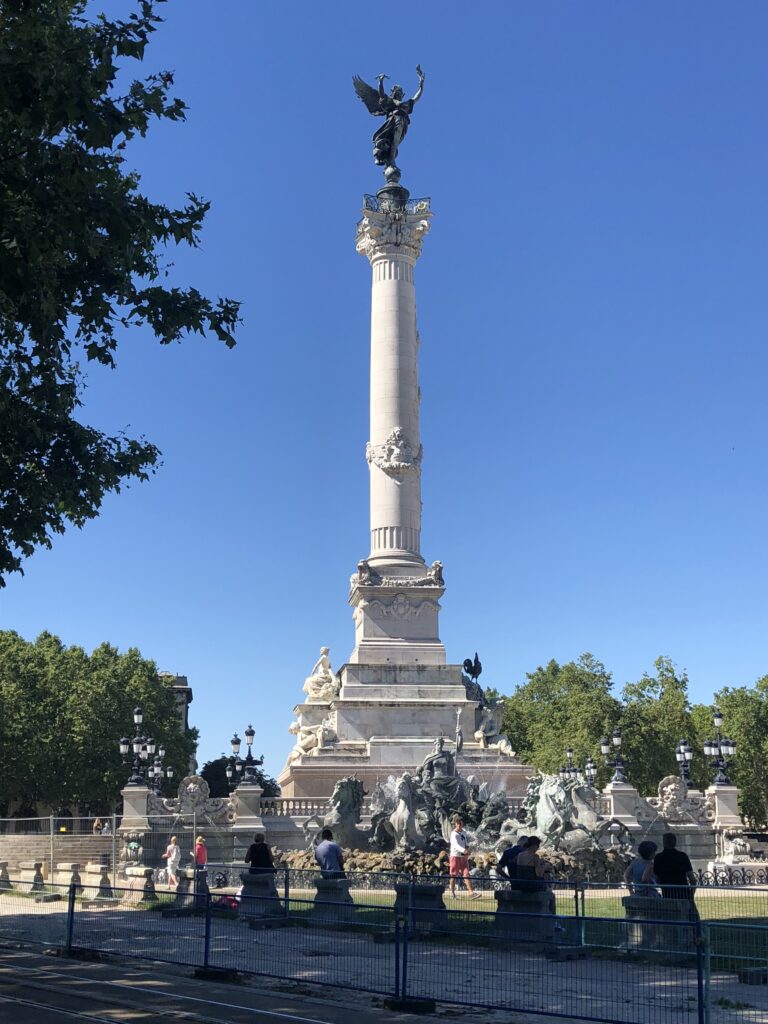
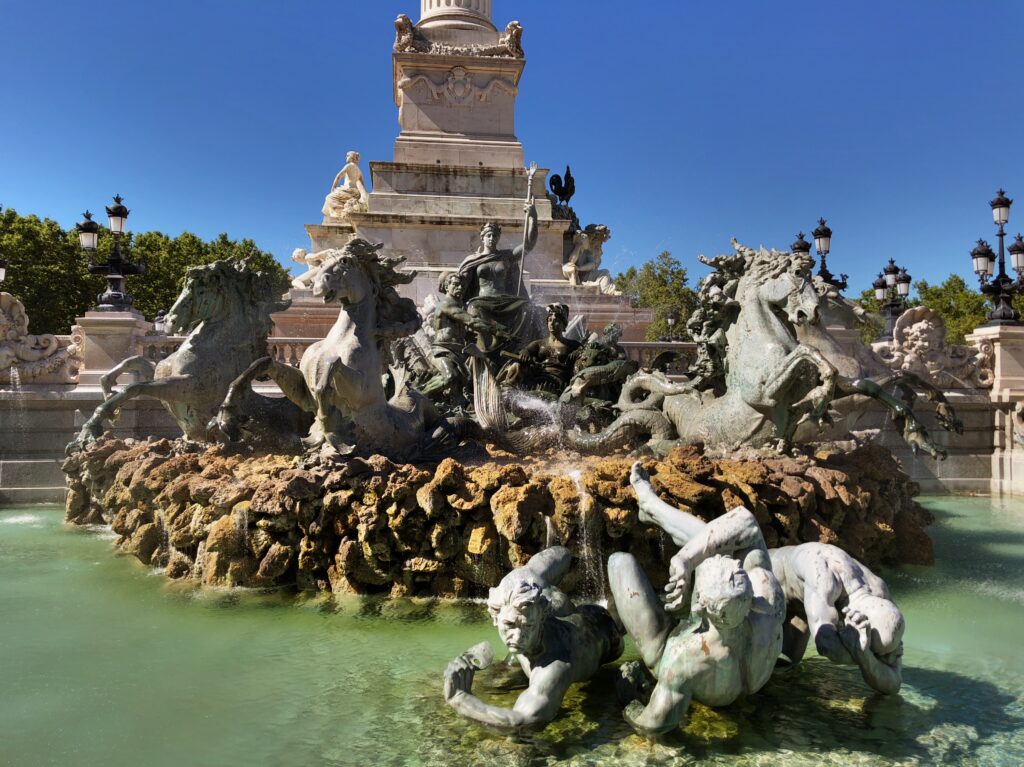
If you’re looking to top off your day with a little shopping, head to the western edge of the historic center, and you’ll find Rue Sainte Catherine, the longest pedestrian shopping street in Europe, with both local shops and national retail stores.
For dinner during each of these three days, there is a dizzying array of choices from Michelin-starred restaurants to pizza places to cozy cafes. It is hard to go wrong. Any food establishment that is surviving in foodie-Bordeaux is going to be fantastic.
Just be sure to have a glass (or two) of that amazing wine with your dinner.
Day 2 – The Right Bank
Exploring the Bordeaux wine region is almost impossible to do in one day. Two days is much better, allowing for a “highlights” tour. (Three days would be better yet!)
Given the extensive region, it is a good idea to hire a local professional tour guide. We opted for a private tour with SIP Tours (Small, Independent Producers) and highly recommend the company. The owner, Nicolle Croft, put together a perfect itinerary for us, after asking all kinds of questions about our tastes and preferences. Our two days were divided into the right bank and the left bank. For a less expensive option, take one of the well-rated small group tours of each bank.
Our right bank tour started with a visit to the charming village of Saint-Émilion, founded in the 8th century, and built on a limestone plateau. It is a series of layers, for lack of a better description. The bell tower is on top, and then a street winds downward, with ancient buildings, beautiful cloisters, shops, and cafes at each level. It is a special, even sacred-feeling place.
From the bell tower, the views are amazing. Surrounding the town is the wine region for which the village is named.
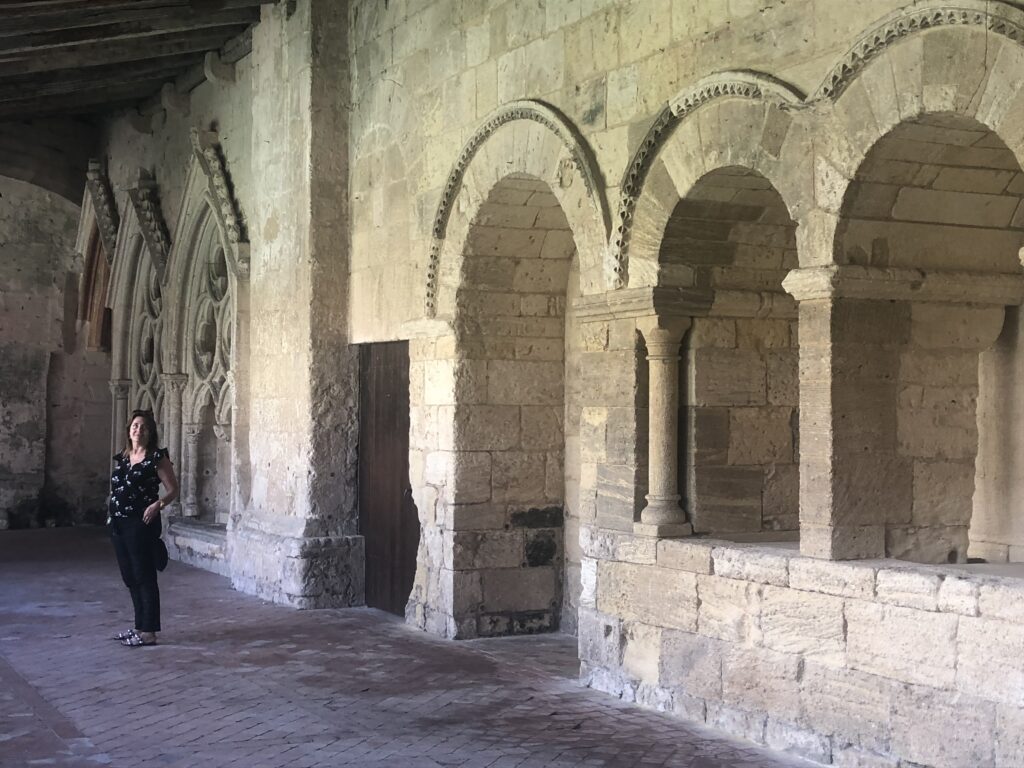
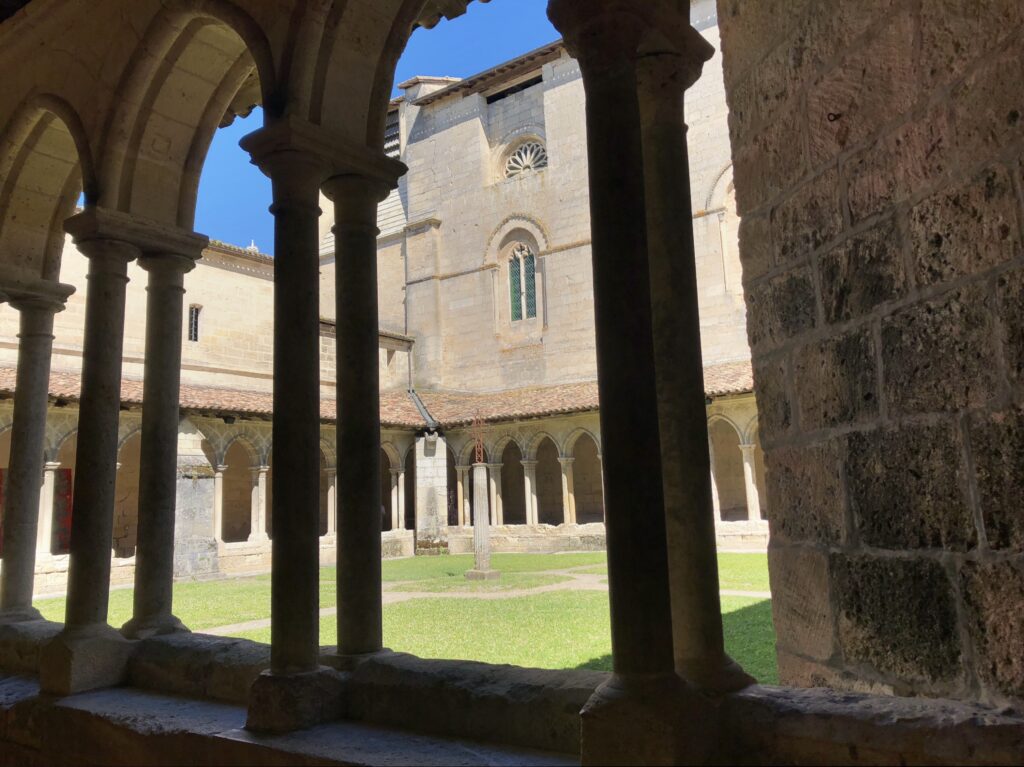
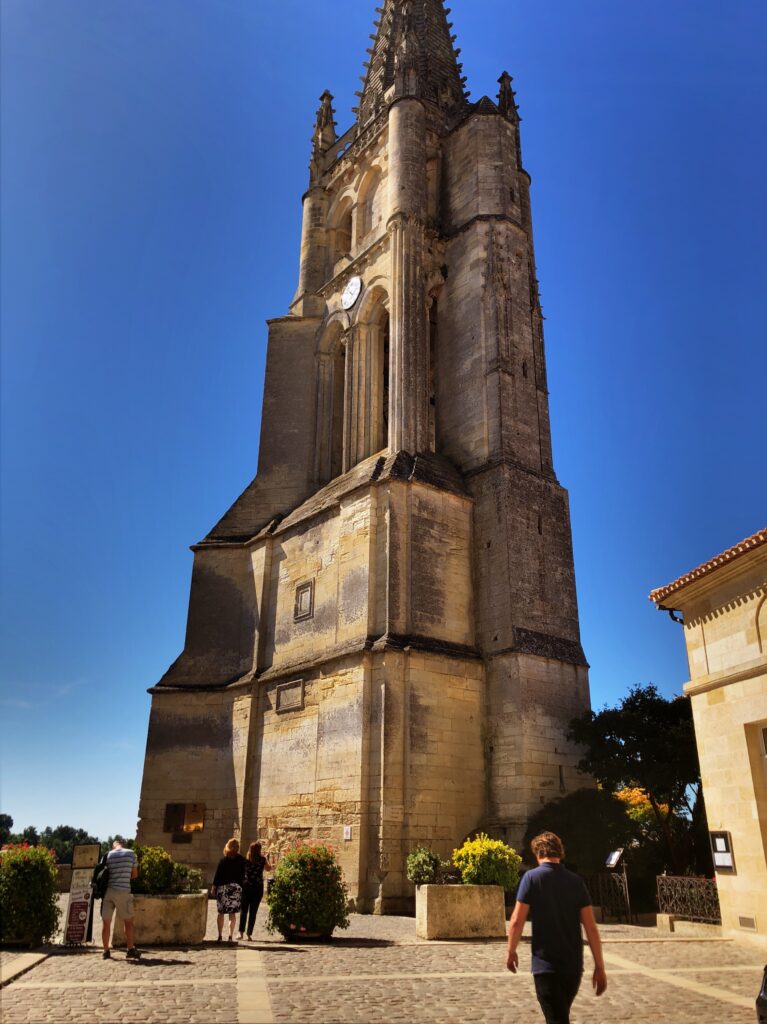
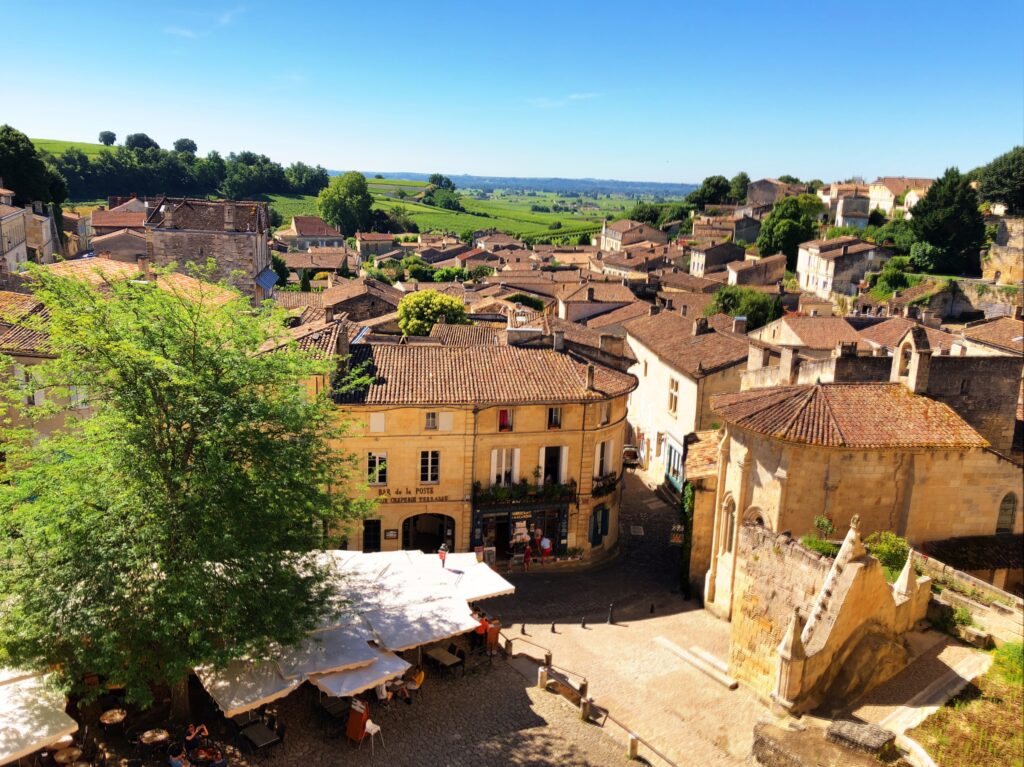
Some of the world’s most famous merlot-based wines are produced here. There are countless vineyards available to visit. Seeing at least 3 of them allows you to see contrasting sizes and styles and, with so many different types of soil in the area, very different-tasting wines. Three excellent vineyards are listed below, but there are many others to choose from.
Just a few minutes drive from the village is Château Laniote, producing Grand Cru Classé wines. It is an 8th generation estate currently owned by the eccentric and delightful Arnaud de Filolie, who conducts the tours himself.
In addition to explaining the wine-making process in an informative and animated way, and leading visitors through the vat house, the bottle storehouse, and the barrel cellar, Arnaud also performs magic tricks! (He even magically and quite unexpectedly “tied” our wrists together at one point.) The tour ends with a tasting of their excellent wines.
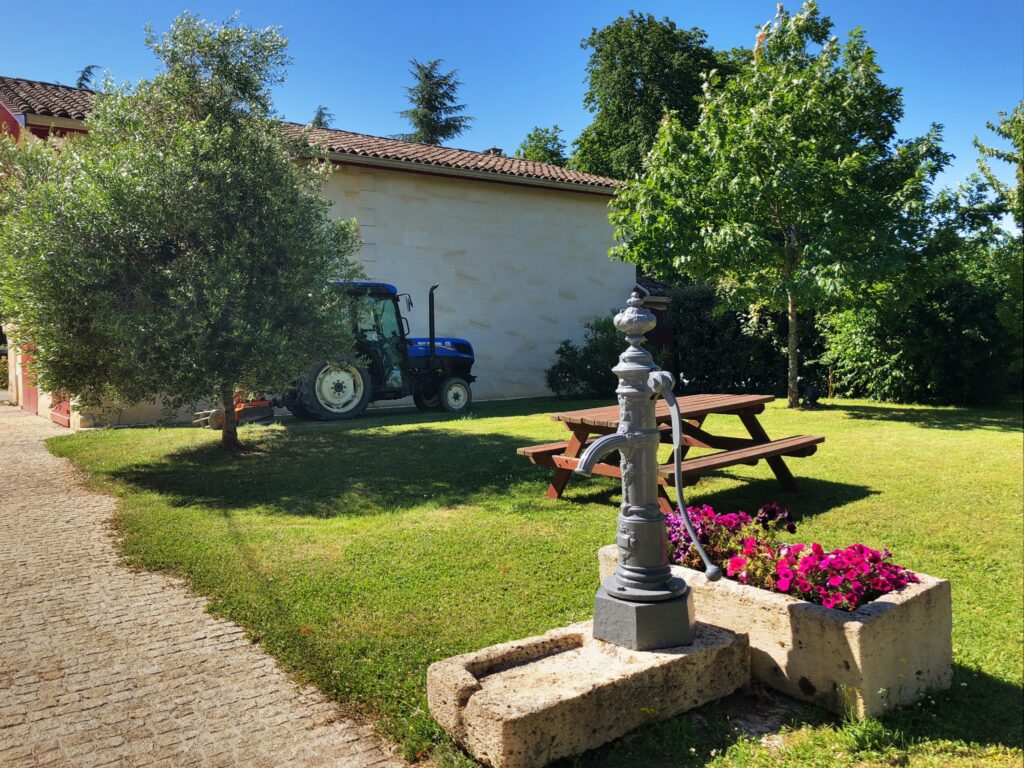
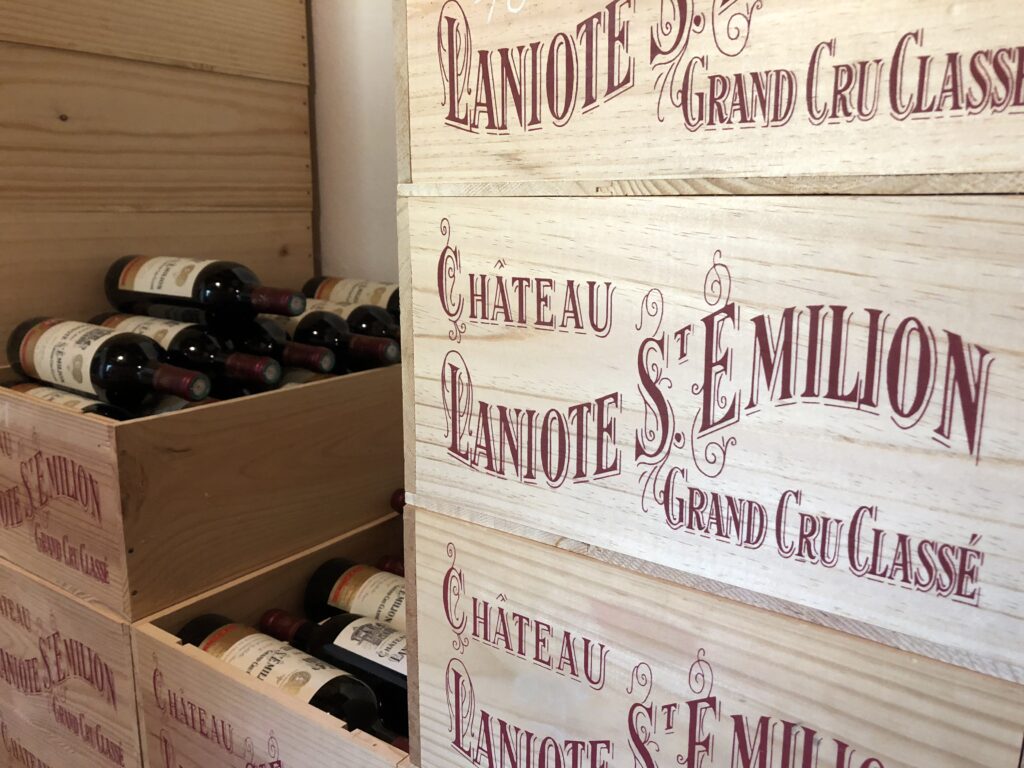
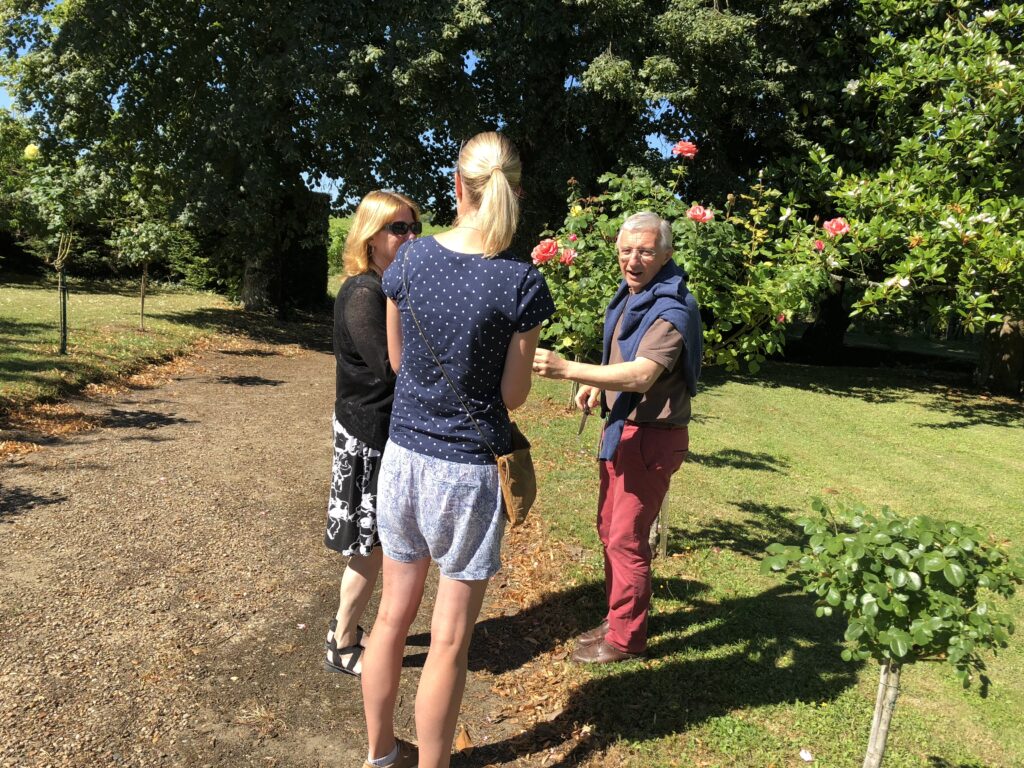
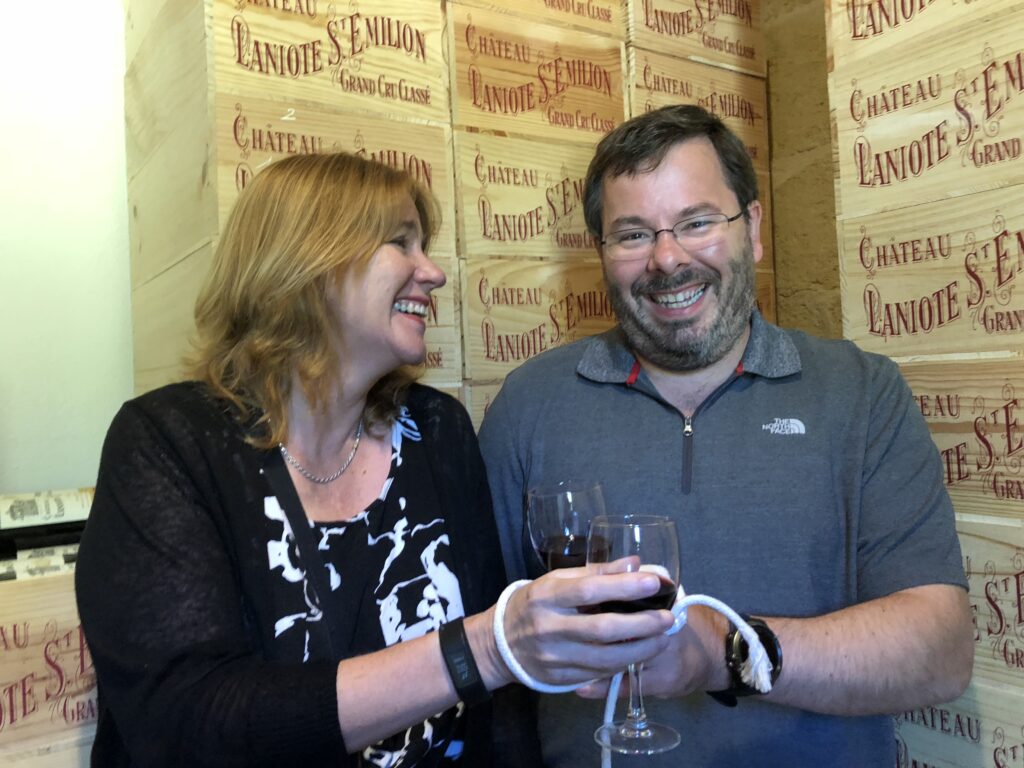
Nearby Château Beausejour Becot is a larger family-owned estate. They are one of only a handful of vineyards to produce Premier Grand Cru Classé wines in Bordeaux, so the tasting here is especially delicious!
The château has an enormous cellar with an underground maze, of sorts, that is surely 5000 square feet or more. At one time, nearly the whole town of Saint-Émilion could be accessed with this type of underground network. The family’s private collection of 7000+ bottles of wine is stored there, along with an incredible amount of history. No need for air conditioning or humidity control, the cellar provides a perfect climate. The caves are amazing and fascinating, but a little bit creepy! It is a memorable experience, but also a relief to get back above ground.
The third châteaux we visited was our favorite in Bordeaux, and possibly our favorite anywhere. Châteaux Coutet is run by the 13th and 14th generations of the same family – the oldest in Bordeaux.
Alain David Beaulieu, a dashing, passionate young man, runs it now. We are confident he works 18-hour days and loves every minute of it. He was called from laboring in the field to greet our group and show us around. His family’s vineyard could be sold, as those have all around him, at truly astonishing prices. He wasn’t at all specific, but the implication was tens of millions of euros. They aren’t interested.
Extraordinarily, the vineyards are organic and have been so for 400 years – long before the word even had any meaning. For all of time, their land has been untouched by chemicals. They don’t even use mechanical equipment; their ground is still cultivated by horses, just as it has always been.
The vineyards are the valuable part, not the buildings. It is a humble place, with two rather modest homes (certainly when compared to surrounding homes) in which Alain, his uncle, his grandma, his sister, and his sweet dog live. They don’t have a staff or a large reception room like the rest of the châteaux have. They all have dirt under their fingernails, so to speak. These people do not lead a wealthy life, at least not monetarily. They are infectiously enthusiastic, and they love their life and their land.
Needless to say, we placed an order for a case of their excellent Grand Cru wine, and are still enjoying it on special occasions.

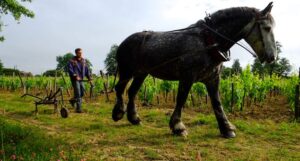
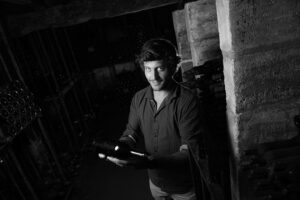
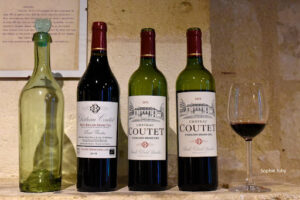
Day 3 – The Left Bank and Cap Ferret
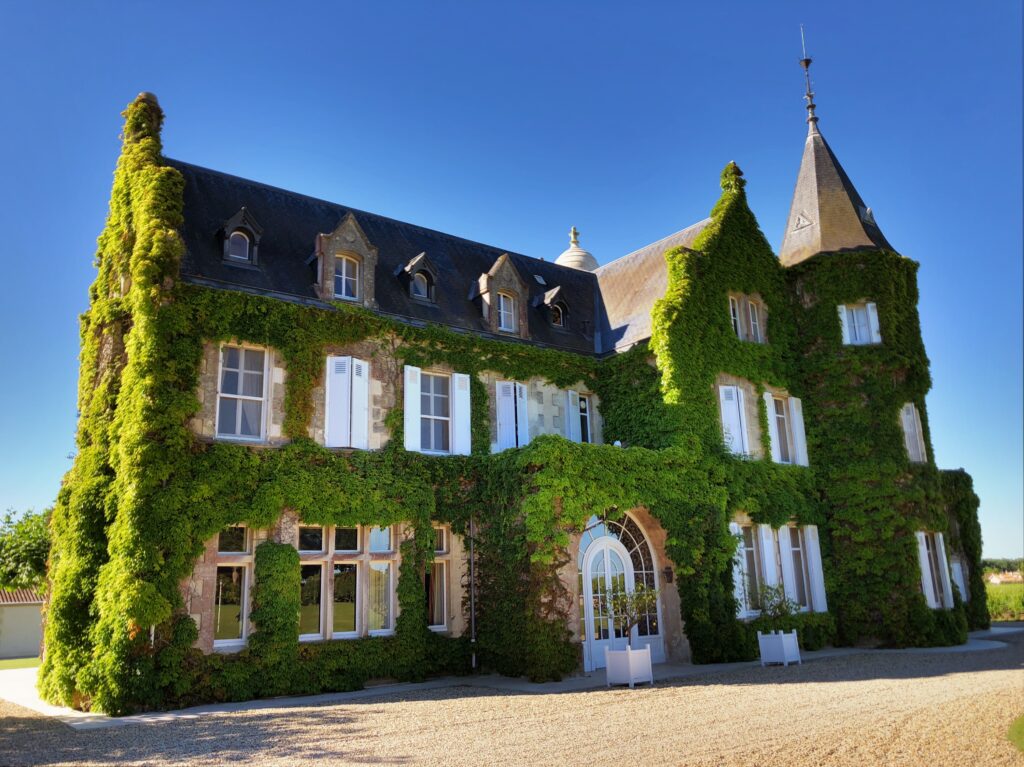
Cabernet Sauvignon is king in the iconic Médoc wine region on the left bank. Visiting the grand châteaux in the area is an elegant and enchanting affair, and quite different from the Saint-Émilion area. It is important to see both to fully experience Bordeaux.
If you have a full day, you can follow the Route des Châteaux, a 30+ mile road along the Médoc Peninsula highlighting many of the wealthiest, most dazzling, and most famous estates. (Reservations are needed to go inside the châteaux.). This can be done with an organized tour, or on your own.
As an example, Château Du Tetre, in Margaux, is a gorgeous 1000-year-old estate producing Cabernet Sauvignon, Merlot, Cabernet Franc, and Petit Verdot. Such estates don’t generally offer tours by the owners, but instead have outstanding staff to welcome visitors in plush tasting rooms and educate them about their specific wine-making processes. Though an informative and enjoyable tour, it is a bit like window shopping, as the majority of (truly magnificent) wines are far outside the price range of most people. (The cover photo for this article is from this château.)

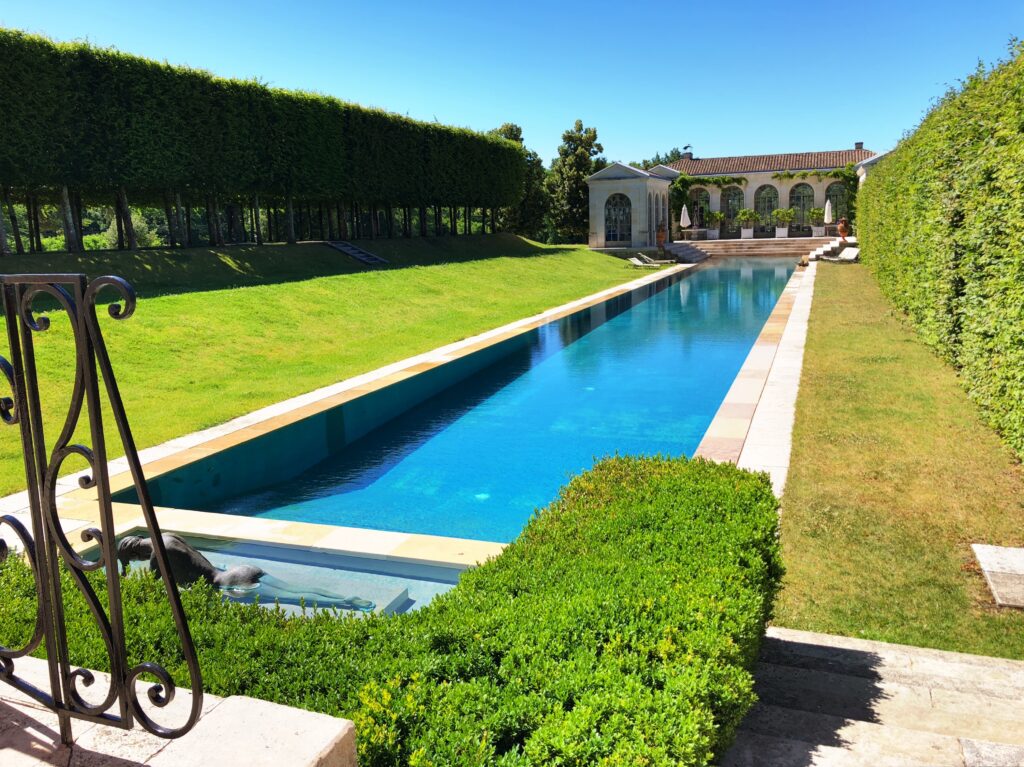
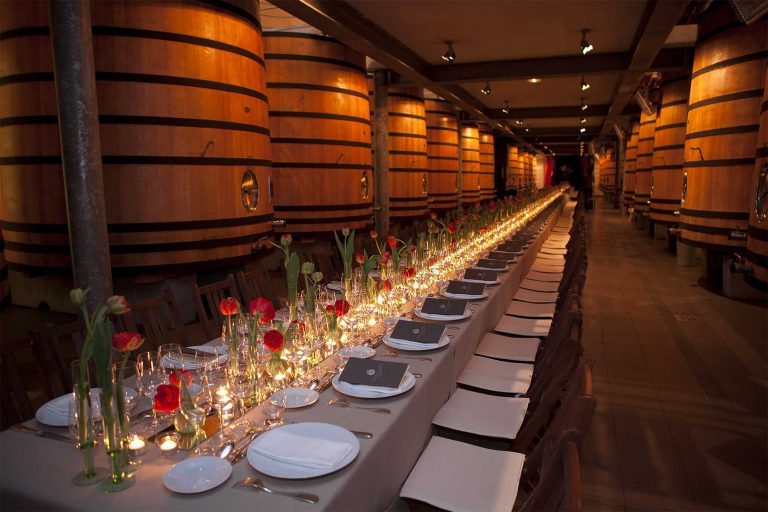
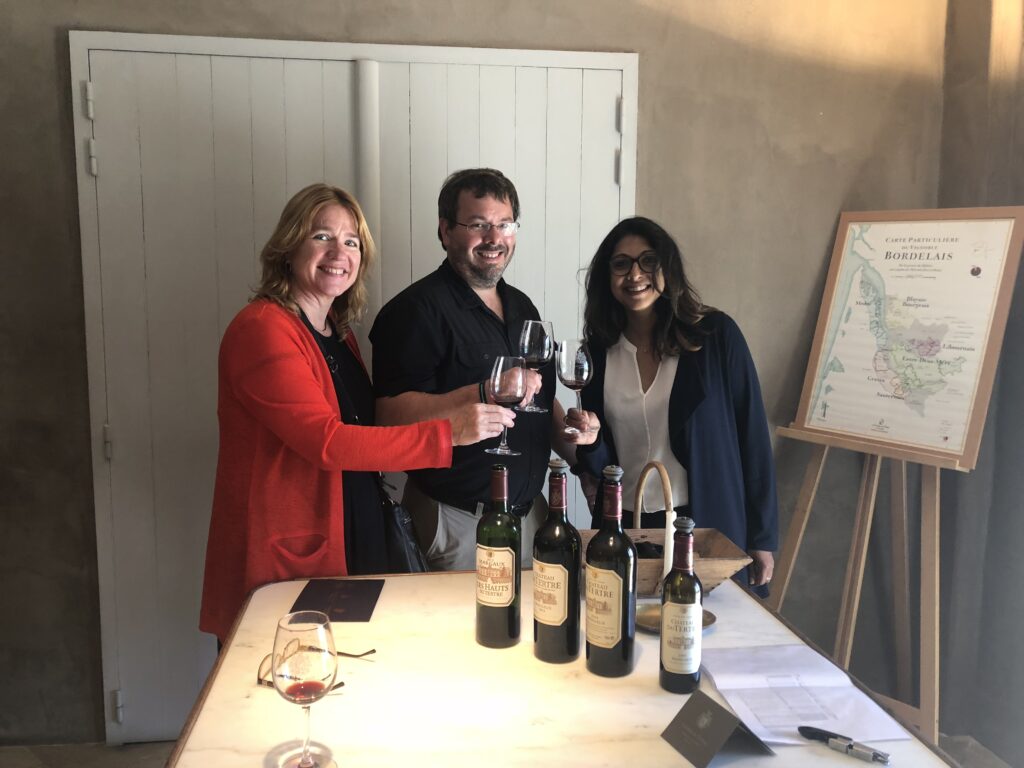
A little over an hour’s drive (and yet a world away) from the Médoc area is a small, delightful, laid-back beach town on the tip of a peninsula in the Atlantic Ocean: Cap Ferret. (Ferret, as in rhyming with “away”. Not like the rodent!) The town is known first and foremost for its oysters.
Oyster farmers line blocks of the town. They have set up shop with little “cabanes”, which are basically small wooden shacks. They were there long before the town became popular. They are allowed by the town to keep this primo land and to offer oyster tastings to visitors. The tables sit so close to the water you can practically dip your toes in it.
However, the farmers are only allowed to serve oysters, shrimp, bread, wine, and water. Not even coffee! Otherwise, they lose their valuable license for their spot. (Apparently, the town doesn’t want them to interfere with business for the nearby restaurants.)
But, oh, what does one really need other than a spectacular view while enjoying the freshest oysters imaginable, a slice of bread, and a shared bottle of wine? Heaven!
Once you’ve had your fill of fresh oysters, Cap Ferret is a traditional coastal town with cute local shops and lovely beaches. Allowing for a full day or two to chill out in here (rather than the few fleeting hours we had) would be desirable.
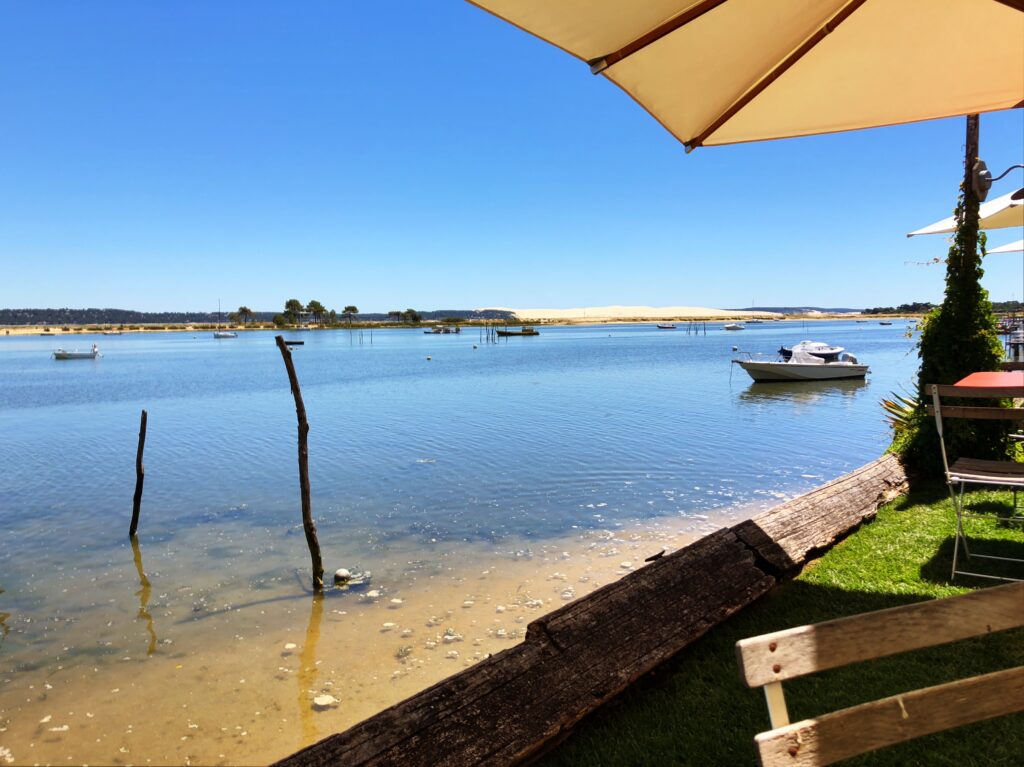
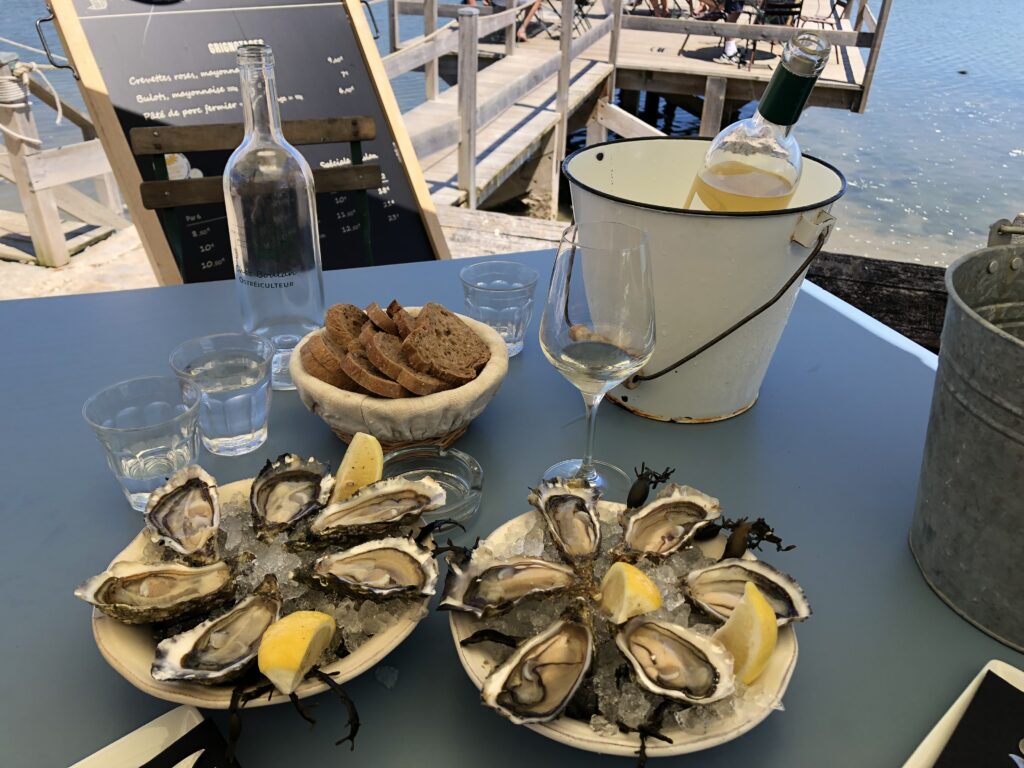
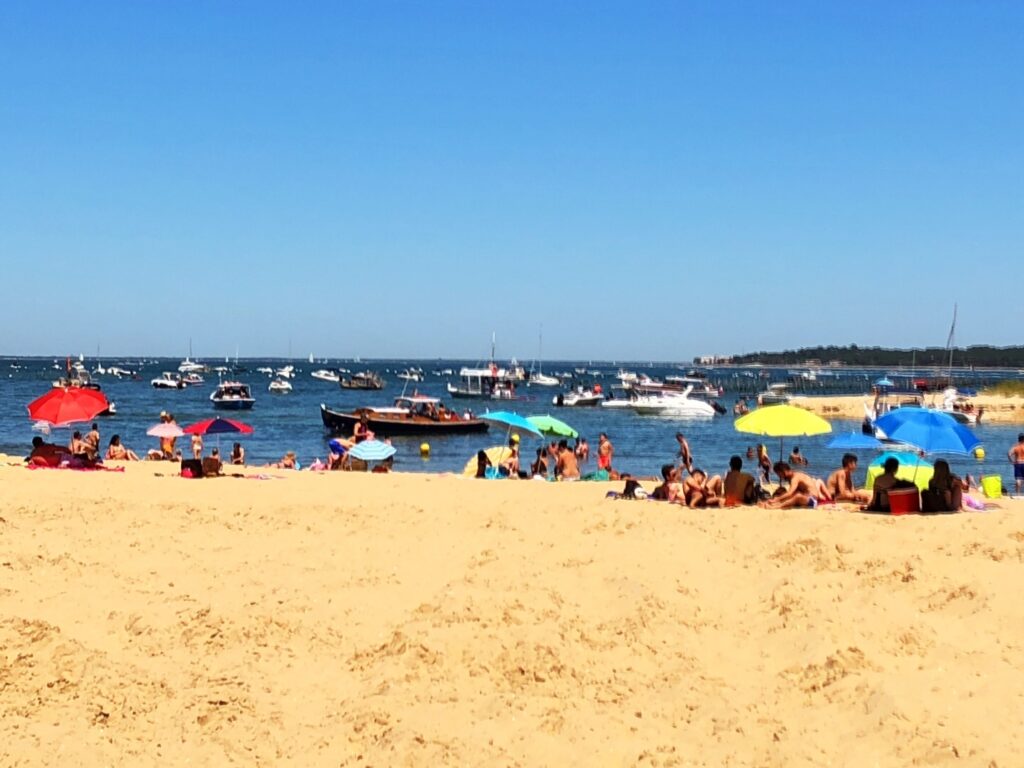
Where to stay in Bordeaux
The major sites in Bordeaux are walkable (except the wine museum) if you book a hotel in the city center. There are lots of options. On a moderate+ budget, it would be hard to beat Hotel de Tourney, a small boutique hotel located in an elegant 18th-century mansion, perfectly located in the historic center of Bordeaux, yet on a quiet street.
The multilingual staff are warm and helpful, the breakfast is wonderful, and the vintage-decorated rooms are small (as is usually the case in Europe), but tastefully appointed, with high-end bedding and towels, are air-conditioned, and are immaculate.
Wherever you stay, as long as it is in the historic city center, you will have easy access, on foot and by tram, to all Bordeaux has to offer.
If you’re continuing your adventures in France, consider our other articles: Paris on Repeat, History, Charm, and Gastronomy in Lyon, and A Taste of Provence.
Discover more from Werthwhile Wandering
Subscribe to get the latest posts sent to your email.

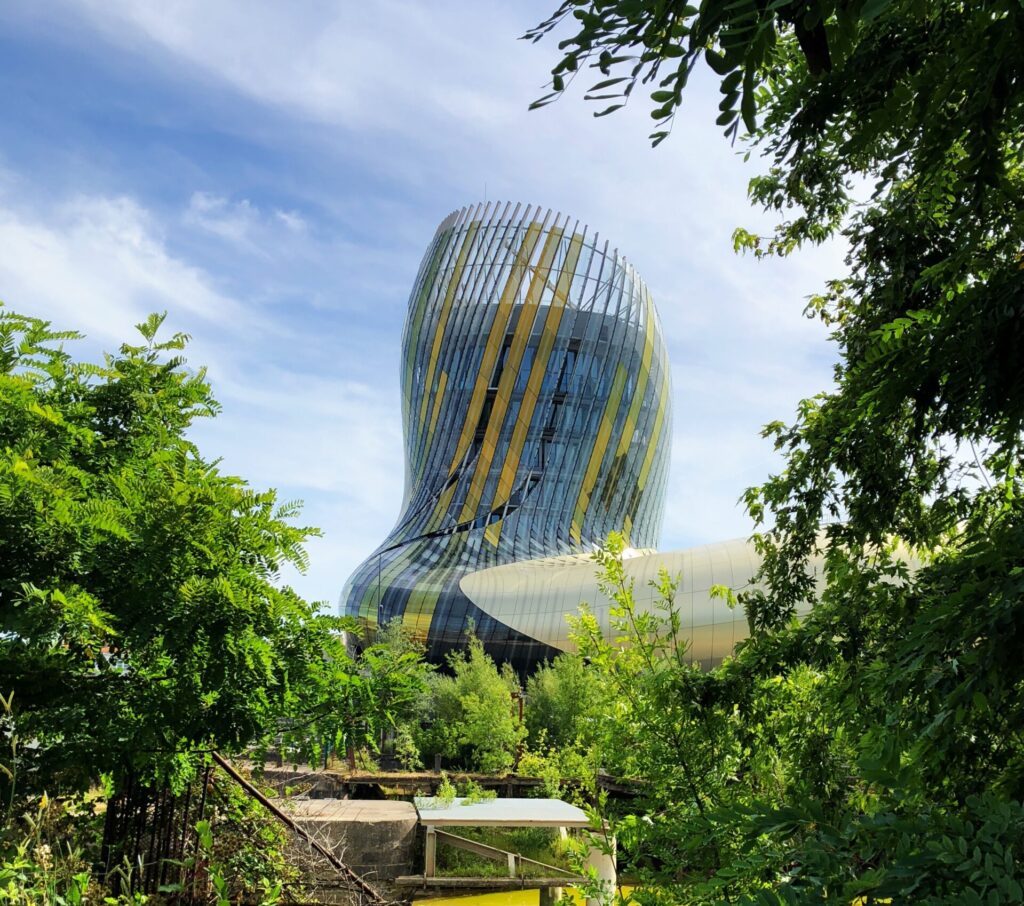
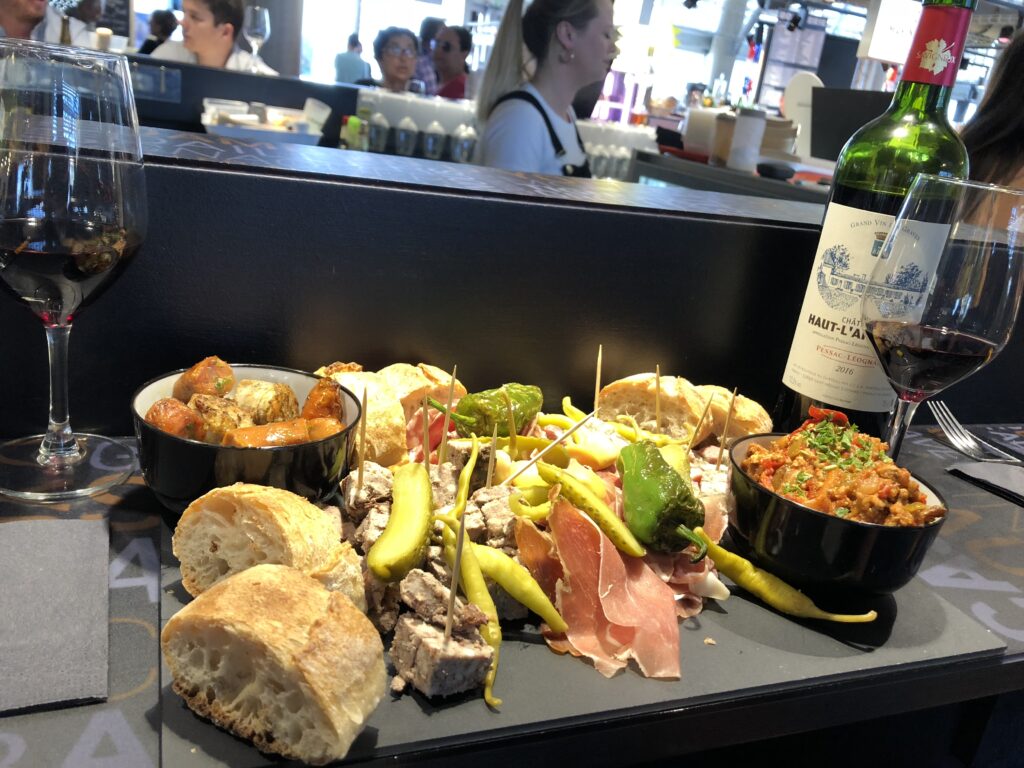
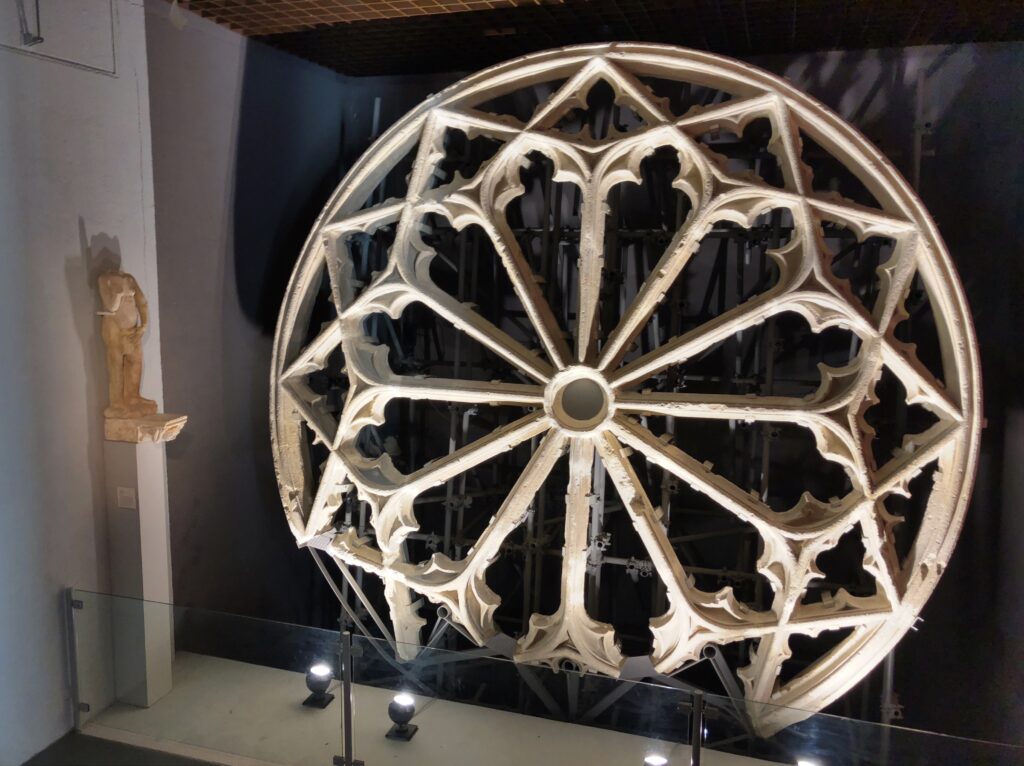
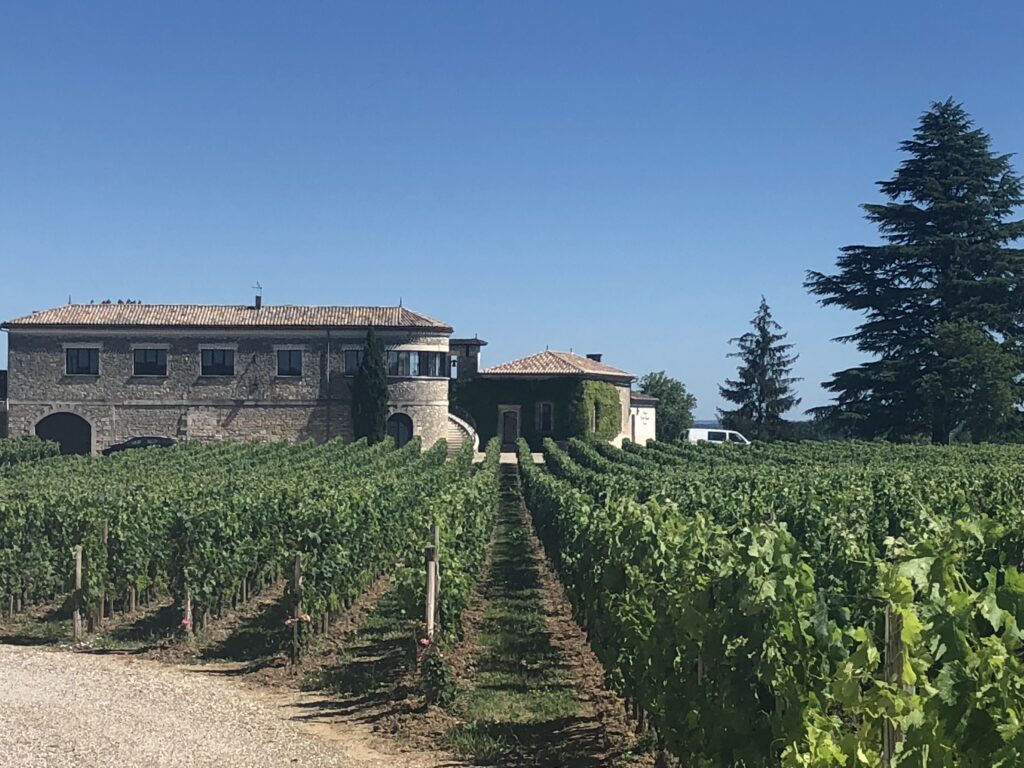




The food looks great and everything, but I’ll be dreaming about that wine!
Such sweet dreams!
Love the suggested itinerary format of this post. Having a sense of the time it might take to visit new places is so helpful for planning!
Thank you! There is a lot of driving time to tour the region, but the scenery is so gorgeous, the time flies by!
LOVE Bordeaux!